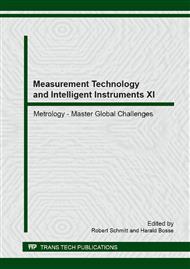p.26
p.37
p.43
p.51
p.58
p.64
p.70
p.81
p.87
Model and Measurement Method of Optical Nonlinearities Caused by the Heterodyne and Homodyne Interference Terms in the Heterodyne Interferometer
Abstract:
The heterodyne laser interferometer is widely applied in ultra-precision displacement measurement, but its accuracy is seriously restricted by the optical nonlinearity which arises from the optical mixing in the reference and measurement arms. In an ideal heterodyne laser interferometer, the beam from the laser source consists of two orthogonally linear-polarized components with slightly different optical frequencies and the two components can be completely separated by the polarizing optics, one traverses in the reference arm, the other traverses in the measurement arm, both of them are in the form of a pure optical frequency. However, in a real heterodyne laser interferometer, due to the imperfect laser polarization, the optics defect and the misalignment, the two components of the laser beam cant be perfectly separated, therefore both of the reference arm and the measurement arm contain a portion of the two laser components, which leads to an optical mixing in the two arms of the heterodyne interferometer and causes the cyclic nonlinearity of several to tens of nanometers.
Info:
Periodical:
Pages:
58-63
Citation:
Online since:
May 2014
Authors:
Price:
Сopyright:
© 2014 Trans Tech Publications Ltd. All Rights Reserved
Share:
Citation:


